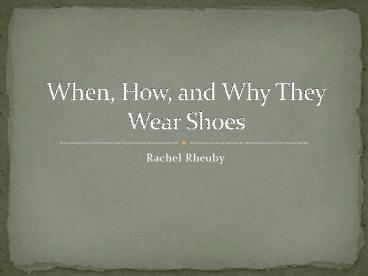Rachel Rheuby - PowerPoint PPT Presentation
1 / 13
Title:
Rachel Rheuby
Description:
The farrier chooses the most compatible size and adjusts the shoes to fit the horse's hoofs. Commercially produced horse shoes are used to save the farrier time. ... – PowerPoint PPT presentation
Number of Views:93
Avg rating:3.0/5.0
Title: Rachel Rheuby
1
When, How, and Why They Wear Shoes
- Rachel Rheuby
2
When did they start wearing shoes?
- Prehistoric drawings dated from the 2nd
millennium BC show men and women on horseback.
Early Asian horsemen used horse booties made from
leather and plants. During the first century, the
Romans made leather and metal shoes called
"hipposandals". By the 6th and 7th centuries,
European horsemen began nailing metal shoes to
horses' hooves.
3
- The 13th and 14th centuries brought the
manufacturing of iron horseshoes. Hot-shoeing,
the process of heating the horseshoe during the
shoeing of the horse, became common in the 16th
century. - Also, the term "farrier" has changed considerably
over time from a horse doctor to a person who
shoes horses.
4
- In 1835, the first U.S. patent for a horseshoe
manufacturing machine was issued to Henry Burden
of Troy, N.Y. Burden's machine made as many as
sixty horseshoes per hour. - Patented improvements have been on the rise ever
since.
5
The How Steps of basic horseshoeing
- All farriers have knowledge of hoof anatomy and
spend a lot of hours in a classroom and with
professionals learning this particular art.
6
- Steps of shoeing horses
- 1. Trimming
- 2. Fitting the shoe
- 3. Applying the shoe
- 4. Scheduled up keep on your horses feet (regular
trimming and re-shoeing).
7
- Tools needed for trimming and shoeing
- 14" Hoof Nippers
- Curved Jaw Clinchers
- Crease Nail Pullers
- Pull Offs
- Hoof Knife
- Driving Hammer
- Shoeing Apron
- 5/16" Farrier Tongs
- 1/4" Farrier Tongs
- Rounding Hammer
- Rasps and Handles
- Butcher Block Brush
- Tape Measurer
- Knife Sharpener
- Shoeing Box
- Safety Glasses
- Anvil Devils
8
- Shoes
- The farrier chooses the most compatible size and
adjusts the shoes to fit the horse's hoofs.
Commercially produced horse shoes are used to
save the farrier time. An experienced farrier
could make the entire shoe from a single piece of
iron. All horses are different and the growth of
their hoofs determined how often the horseshoes
have to be removed and reset. Average reset is
once every five to six weeks.
9
Why we Shoe?
- The main reason we shoe horses is for work, which
determines the style and the type of shoes we
choose for the individual working horse. When we
are shoeing a horse, we try to shoe him in such
way to improve his working capacity and make the
work easier and safe. We also shoe horses to
prevent wearing of the hoof.
10
Corrective Shoeing
- Many farriers will say that "corrective shoeing"
is a term that horse owner overused. "Corrective
shoeing" in the case of mature horses is simply
shoeing treatments for conformation problems of
the feet and legs, compensatory shoeing is a
more accurate term. The problems are temporarily
fixed by shoeing and trimming. When the shoes are
removed the problem still exists the horse's
conformation is unchanged.
11
- Older sound foot-sound horses will maintain when
it is trying to overcome foot damage or leg
injury. The horses poor conformation causes it to
apply weight unevenly to his feet. In the case
that is illustrated on the right, corrective
shoeing will be used to rebuild strength and
balance to the horse's feet and legs. - These circumstances can be prevented and
corrected. To leave them uncorrected can cause
infection and the possibility of death!
12
- In the case of younger horse, conformation change
is a primary importance. Correction of a faulty
conformation is possible but only under certain
circumstances. For permanent change to be
possible in the young horse's conformation, the
horse must be still growing at the location of
the fault particularly the physical growth plates.
13
- Now that you have some basic knowledge of when
horseshoeing got started, how we shoe, and why we
shoe I hope that you understand why it is
important that you pay attention to your horses
feet. Make sure he shows correct conformation so
he doesn't become his own enemy. Also you should
know if you farrier is doing a professional job.
If your horse doesnt have feet or legs then what
else is left to ride?































